|
|
Starving for any attention, the carbon-haters need to find a reason to get into the inflation debate. CO2 keeps rising but crops are up, forests are greener, tropical islands are growing, mangroves are expanding, and the world is in more danger of being overrun with cheap soy and corn than by rising seas. Whatever. The disaster-bus will find a way to blame fossil fuels for everything that’s bad, as if through some miracle EV’s and windmills will make pork cheaper.
It’s a cult:
Climate crisis is ‘battering our economy’ and driving inflation, new book says
Edward Helmore, The Guardian
Forget Ukraine, coronavirus, corporate greed and “supply chain issues”, when it comes to inflation the climate crisis is the real, lasting, worry, according to a new book, and one that’s only likely to get worse. Climatenomics lays out how ‘supply chain disruptions’ has become a euphemism for the effects of climate change
“I don’t think people have realized that climate change is an economic issue now because it’s always been seen as an environmental, health or social issue,” says Keefe. “The fact of the matter is climate change is battering our economy.”
Any long term trend will do, even a really short one:
According to Keefe, citing National Oceanic and Atmospheric Administration (Noaa) figures, climate-related weather disasters cost the US economy more than $145bn in 2021 – a nearly 50% increase from last year.
Then Any big Scary Number will do. Lordy Maths! Just say “trillion” and give me your money:
Over the last five years, they have cost $750bn. Since 1980 323 weather and climate disasters have cost $1bn or more, the total cost of these events exceeds $2.195tn.
Nevermind that the long term cost of climate losses is growing smaller as a percentage of GDP.
As I said five months ago when it was obvious that 2022 would be the Year of Inflation, more money, means more inflation:
More dollars fighting over the same stuff means higher prices. It’s just a supply and demand thing. This is the money base of USD, a rough measure of “how many dollars there are”. It’s obvious where this is going and it isn’t a temporary spike:
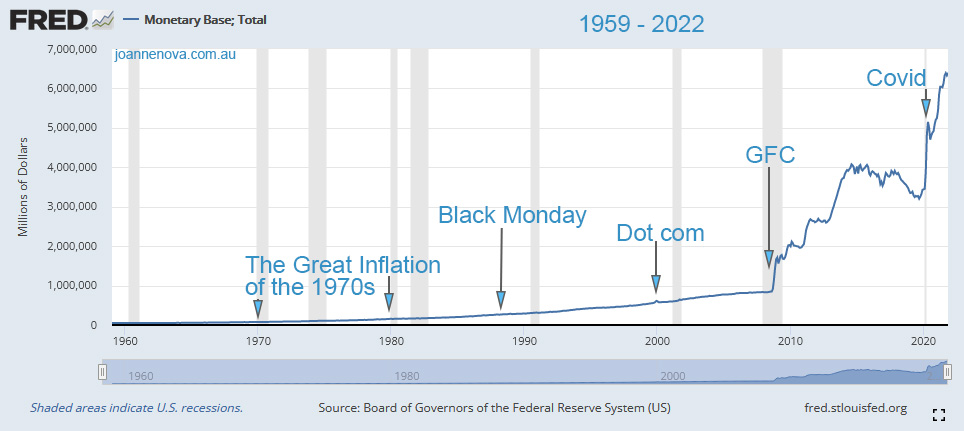 US St Louis Federal Reserve, Money Base graph 1918-2008 | Source Cause and effect.
REFERENCES
St Louis Federal Reserve: AMBSL and BOGMBASE
Piekle, Jnr (2018) Tracking Progress on the Economic Costs of Disasters Under the Indicators of the Sustainable Development Goals, Environmental Hazards. https://www.tandfonline.com/doi/full/10.1080/17477891.2018.1540343
A complete list of things caused by global warming: Numberwatch
Plus shorter lists:
h/t Graeme No.3
9.7 out of 10 based on 61 ratings
…
9 out of 10 based on 8 ratings
Year after year they told us it would get warmer, ski seasons would get shorter and children won’t know what snow is. Instead Thredbo in the Australian Alps has just had 125cm of snow, a full 4 feet in 7 days, which some are calling a 54 year record. Skiers in Australia are thrilled.
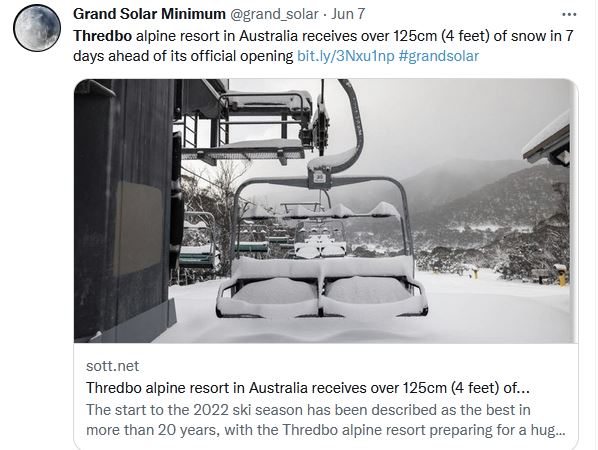 https://twitter.com/grand_solar/status/1534181676854788097 Daily Telegraph
In my many years living and working in Thredbo, I have never seen the Village so covered in snow ahead of the June long weekend,” Thredbo Resort general manager Stuart Diver said.
In the year 2000 the world’s top global warming experts at East Anglia University claimed “children just aren’t going to know what snow is” within a few years.
In 2003, a CSIRO report found that the total area covered by snow in Australian mountains could fall by up to 40 per cent.
“By 2020, the average annual duration of snow-cover decreases by between five and 48 days; maximum snow depths are reduced and tend to occur earlier in the year; and the total area covered in snow shrinks by 10-40 per cent,” it stated.
Think tank IPA’s senior fellow Dr Jennifer Marohasy said it had been a cold start to winter but because the Bureau of Meteorology had closed down weather stations and set limits on stations recording cold temperatures, it made comparisons difficult.
As Jennifer Marohasy says, they’ve closed long standing stations, and set limits of minus 10.4 C so if Australia were to break our long time cold records we’ll never even know it. Charlottes Pass in Australia reached minus 23 in 1994. How can we even measure that with thermometers that “stop” at minus ten?
9.9 out of 10 based on 93 ratings
EnergyAustralia is 100% owned by China Light and Power (CLP Group) and owns a suite of generators that include coal, gas, wind farms and battery storage in Australia. It was sold by the NSW government for $1.4 billion in 2011. According to Wikipedia, the mothership company, CLP, owns “a number of power stations in Asia” and most are either coal-fired or fossil fuel power stations. It also owns Hong Kong Nuclear Investment Company.
A year ago the same company that announced it was speeding up the closure of Yallourn coal power plant to 2028 instead of 2032, now warns the transition “may not be smooth” and the governments plan to pay incentives to keep them open “may not be enough”. But back in March last year, when EnergyAustralia said it wanted to close Yallorn, it also said that it wanted to show that the transition is possible “without disruption”. In fact the Managing Director raved at the time “”We are determined to show Australia, that it is possible to move from the old to the new in a way that does not leave people behind.”. Blah Blah Blah, eh?
The plan, apparently, was to close the 1,500MW cheap brown coal plant and replace it with a “large” 350 megawatt battery. The Victorian Minister of Energy said this was reasonable because another 5,000 megawatts of electricity was going to be added to the grid in coming years. Perhaps she didn’t realize that not all megawatts are equal?
Perry Williams, the journalist at The Australian did not ask if EnergyAustralia would profit from getting cheap coal competitors off the grid, thus raising the price every generator earns in the NEM auction system.
Nor did he ask whether the owners, CLP, are calling for orderly transitions out of coal in Asian markets or only in Australia.
Perry Williams, The Australian
Power giant EnergyAustralia will call on governments for a new policy to plan the orderly exit of coal-fired plants from the electricity system amid a growing energy crisis.
EnergyAustralia, which owns the big Yallourn and Mt Piper coal-fired power stations in Victoria and NSW respectively, is under short-term pressure to keep the fossil fuel in the energy mix after a string of big units suffering breakdowns amid a broader crunch in the national electricity market.
EnergyAustralia’s Yallourn station in Victoria – which started operating in 1974 – supplies 22 per cent of Victoria’s electricity and 8 per cent of the national electricity market, but has been under pressure for several years as Australia’s national power grid accelerates a transition to renewable energy.
It will close in mid-2028, more than four years earlier than its planned retirement date of 2032, after striking a confidential deal with the Victorian government. Meanwhile, the final NSW coal power plant will be shut by 2040 at the latest after EnergyAustralia’s decision to bring forward the closure date of its Mt Piper facility by at least two years in a bid to hit new green climate targets.
Did taxpapers pay EnergyAustralia to rush the closure of their own coal assets or are EnergyAustralia trying to hit “new green climate targets” because they are just nice people? Who knows. It’s commercial in confidence. The costs of the Green Transition we don’t have-to-have are always a secret.
Is it possible they will make a motza from shutting cheap coal because they can earn so much more per megawatt hour in a system screwed by a crisis?
9.8 out of 10 based on 58 ratings
10 out of 10 based on 8 ratings
And the bonfire continues
As cold fronts sweep across the south east of Australia electricity prices are setting records nobody wants to set. The wholesale prices for electricity –across a whole month — soared past $300 a megawatt hour in three states of Australia. In NSW the cumulative cost of wholesale electricity for May alone worked out at $2.4 billion dollars. It’s enough to build a power plant. Back in 2015, before Hazelwood old brown coal plant closed and Australia installed more renewable energy per capita than anywhere else on the planet, the average price in NSW was $35/MWh. Back then it cost $260 million for the whole month. (And Hazelwood wasn’t even in NSW. ) The point is not about one coal plant, but about how recently the system still worked and how fast it fell apart. Hazelwood coal plant in 2017 was 53 years old and still selling electricity at $30 per megawatt hour when it was shut down. Since then the whole grid has so much more capacity yet so much less ability. There’s no resilience left. A few speed bumps wiped out the whole road train.
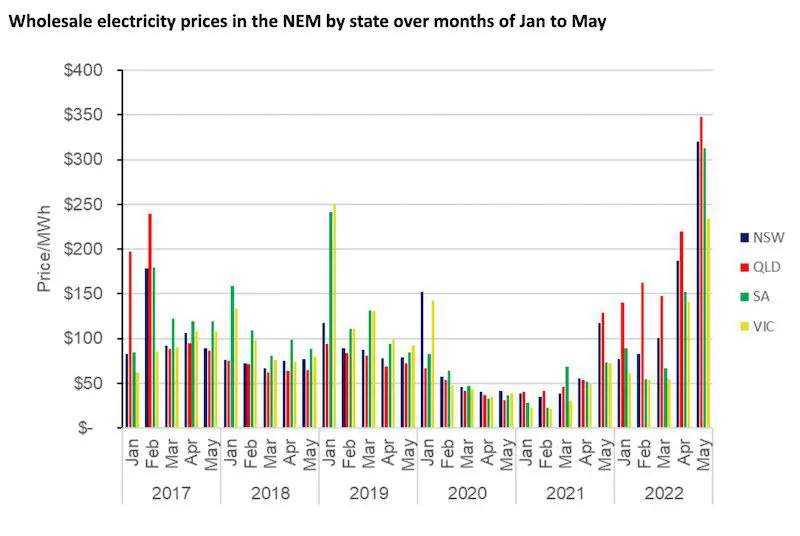 Wholesale electricity prices are higher across the Australian grid than they have ever been The graph comes from Tristan Edis at WattClarity who blames the current fiasco on coal and gas producers “selling at international market prices” saying it’s not a failure of solar or wind. But as Ben Beattie points out we’ve installed 3GW of rooftop solar in 2021, so getting the same power out of it in 2022 is hardly “success”. When the weather systems rained on the coal mines, they clouded up the solar plants. We’re now a weather dependent grid but it didn’t have to be this way. And in January the price of international black coal was $200 a ton but Australian brown coal plants were still winning bids here in Australia at $22/MWh.
If only we had more brown coal plants in good condition?
The wind and solar plants ARE the vandals on the grid
The excess of random wind and solar at subsidized prices mean that cheap reliable providers get driven out of the market and we had no other alternative. It’s exactly what the Soviet-genius energy comptrollers were aiming to do. On top of that, the unloved baseload generators that haven’t been blown up aren’t being repaired and maintained properly. Plus the expert climate modelers said that winter nights would be warmer and they aren’t, and coal was a dead asset, not a $400 a ton asset. And gas wasn’t worth exploring for and we’re a nuclear free zone. It was the same circle of brains that made all the wrong predictions.
When coal and gas hit bonanza prices, Australia should be reaping in the dough. If we had enough brown coal or nuclear plants to lighten the load on the gas and the black coal it would be fine. But we have no back up for the back up anymore. We just have back up for the renewables.
A sneak peak at June prices shows that things are a bloodbath. The average price for the first nine days of June is $440 in NSW and $520 in Queensland. (See the AEMO)
9.9 out of 10 based on 88 ratings
The most important jokes in the world right now are the ones Facebook doesn’t want you to see. Anthony Watts posted a 2018 cartoon which is so “hot” it got removed in just 8 hours.
This cartoon is not a joke, it’s a community safety message.
Source: The original Pat Cross cartoon.
10 out of 10 based on 78 ratings
…
8.3 out of 10 based on 10 ratings
Naturally, its nothing to do with new large medical programs done for emergency use. We know that because of all the detailed human trial data that the FDA and company in question wanted to hide until 2096, and which we still haven’t seen in full.
But if you hear of someone young and healthy dying there’s a word for that now — “normal”, I mean SADS.
Daily Mail
People aged under 40 are being urged to have their hearts checked because they may potentially be at risk of Sudden Adult Death Syndrome.The syndrome, known as SADS, has been fatal for all kinds of people regardless of whether they maintain a fit and healthy lifestyle. The term is used when a post-mortem cannot find an obvious cause of death.
The US-based SADS Foundation has said that over half of the 4,000 annual SADS deaths of children, teens or young adults have one of the top two warning signs present. ‘There are approximately 750 cases per year of people aged under 50 in Victoria suddenly having their heart stop (cardiac arrest),’ a spokesperson said. ‘Of these, approximately 100 young people per year will have no cause found even after extensive investigations such as a full autopsy (SADS phenomenon).’
Unrelated
It’s surprising that it took this long for the media campaign to start.
There are reasons whereby indemnity for pharmaceutical companies or the government might be made invalid — but we can’t tell you that either.
Matthew, Evo of Gong, Kevin a, Scott of the Pacific
10 out of 10 based on 71 ratings
So a lady tried to drive an EV from New Orleans to Chigago and back in less than four days with a car that had a battery life of 310 miles on a trip that was 2,000 miles long. She saved $100 in fuel but the fast chargers weren’t fast, the waits were inconvenient, and then there was the stress and uncertainty of just not knowing, and of wandering around unknown streets on foot, waiting for the car to charge, and trying to make appointments that failed. It took 12 hours to drive a 7.5 hour trip on the way there. But on the return as the weather got worse, so did the battery mileage. Just when you need it, it isn’t there… they ended up getting only 4 hours sleep on the last night so they could allow long enough to fit in the charges on the last leg.
Remember, you’re suffering so your great-grandchildren won’t have too.
Joel B. Pollak, Breitbart
The Wall Street Journal reported this weekend on a four-day road trip from New Orleans to Chicago and back in an electric vehicle (EV) that ended up as a disaster — one that left the author grateful for her ordinary car, even at today’s high gas price.
The Journal article, by Rachel Wolfe, was titled: “I Rented an Electric Car for a Four-Day Road Trip. I Spent More Time Charging It Than I Did Sleeping.” In it, the author described planning the journey, using the PlugShare app to map charging stations and estimate charging times, based on the relative strength of each public charging station. She noted that more charging stations should, in theory, be available in future, thanks to the federal government’s new infrastructure bill.
For now, however, long-distance travel by electric vehicle proved almost impossible, saving just $100 and costing hours. At several points, Wolfe recalled, the car nearly ran out of battery; they missed several appointments. They also had to take drastic steps to curb their use of power, such as unplugging their phones and turning down their windshield wipers.
h/t OldOzzie
9.8 out of 10 based on 66 ratings
The election horse that mysteriously got away
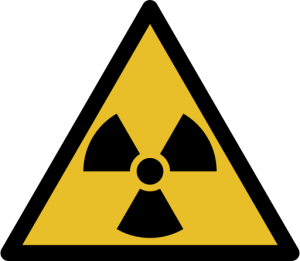
With virtually no public campaign at all, out of the starting gates, 53% of Australians thought nuclear power was good idea. Only 23% were against it. This was a survey done in April. Scott Morrison could have played the brave man-of-action card — (solving the climate wars with a 50 year old tried and true technology!). It would have been an easy sell once Australians found out there were 440 nuclear power plants in the world, and that even Armenia has one. And so does Belarus. Mexico has two, Hungary has four, and the Czech Republic has six. They’re everywhere.
Prime Minister Morrison may have even had these survey results in the lead up to the election? So why didn’t he play that card? Was it really fear of “the anti nuclear” green hippies, or something else…?
The conservative government missed the chance to sell a big vision, and nobble “Climate” witchcraft
Daily Mail
Most Australians want a nuclear power industry to reduce emissions by scrapping coal-fired plants, but it’s unlikely to happen because politicians don’t agree. A poll found 53 per cent in Australians support ‘building nuclear power plants to supply electricity and reduce emissions’ and only 23 pre cent opposed.
Even Greens voters, whose party is fundamentally opposed to it, are warming to the idea with 44 per cent in favour compared to 30 per cent opposed. The nuclear option also gathered 70 per cent approval from Coalition voters, with 13 per cent opposed, and 52 per cent from Labor supporters while 27 per cent opposed.
The survey of 1,000 people was commissioned by the Institute of Public Affairs in April.
Make no mistake, the cheapest solution to our power crisis starts with checking the scientific evidence of the foreign committee in Geneva that claims CO2 causes a catastrophe. For a mere 0.00001% of what we spend on renewables we could discover that the hot spot is still missing, the models were wrong, and CO2 is good for crops, forests and desert plants. We’d be free to use cheap brown coal power at 3 cents a kilowatt hour wholesale.
Nuclear isn’t that cheap but it’s better than the bonfire extravaganza of Snowy 2.0 pumping to nowhere, plus billion-dollar interconnectors, burning batteries and bird killing windmills.
France built 56 nuclear plants in just 15 years. Imagine how silly the conservatives will look if the Labor Party manages to build the first nuclear plant in Australia?
Image Cary Bass |
10 out of 10 based on 78 ratings
Great Headlines in Science:
“Climate crisis could make humans shrink in size, says fossil expert”
 Where science is just like a movie set It’s another great moment in science leaving beleaguered teenagers wondering if their kids will be shorter than them. Perhaps if they can buy an EV, they wonder, Johnny will be as tall as his dad?
Or maybe the journalist could have said “in five million years” because that’s the kind of time-frame this scientist is talking in:
Nicola Davis, The Guardian
The climate crisis may lead the human race to shrink in size, as mammals with smaller frames appear better able to deal with rising global temperatures, a leading fossil expert has said.
Let’s make that “in five million years without air-conditioning”. Because the whole story applies to humans living au naturel, like Eocene Horsies did.
Prof Steve Brusatte, a palaeontologist at the University of Edinburgh, suggested that the way in which other mammals have previously responded to periods of climate change could offer an insight into humans’ future.
He likened the potential plight of people as similar to that of early horses, which became smaller in body size as temperatures rose around 55m years ago, a period called the Paleocene Eocene Thermal Maximum.
If only solar panels had been around to save Eohippus from shrinking eh?
But it takes about three minutes research to find out the tallest humans don’t live in Iceland, but in Rwanda, Sudan, North America, or Bosnia, or probably wherever the best damn steaks are the easiest to catch. Apart from genes, Human height is largely due to protein intake, so if everyone goes vegan, “to save the planet” climate change will definitely make humans shrink.
Brusatte’s reasoning is essentially to ignore that air-conditioning neutralizes natural-selection-by-temperature, to talk about 50 million year old horses, and quote a Nature paper on environmental variables that predict human body size in the last million years. But the Nature paper doesn’t measure or even mention dietary protein. It’s another rabbit-hole-to-nowhere by academic specialists who didn’t pick up the phone find someone who knew as much as a well-read blogger.
Every time we spent tax dollars to find a crisis, instead of finding the truth, we ruin science a little bit more.
Save Science. Stop Government Funding Now!
Movie poster: The Incredible Shrinking Man.
10 out of 10 based on 50 ratings
7.4 out of 10 based on 10 ratings
Ted Nordhous argues powerfully that Climate Change is simply not the main event anymore, and the climate punters are shellshocked.
by Ted Nordhous, Foreign Policy
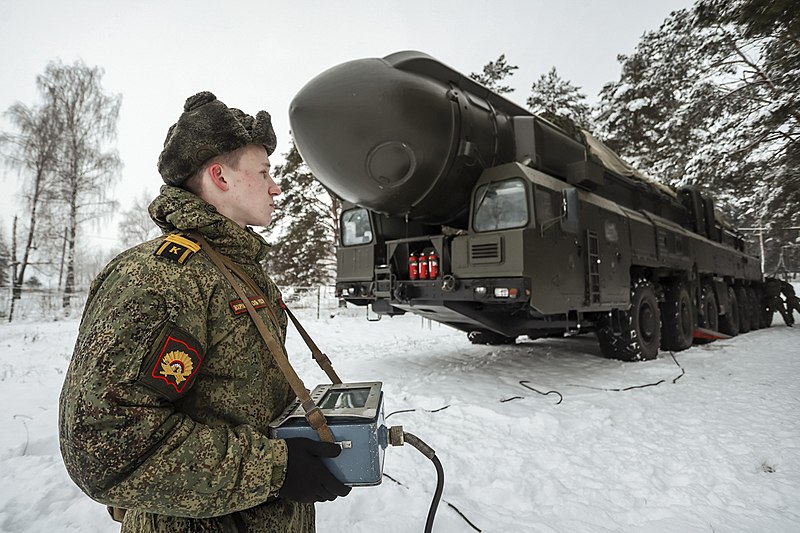
Tactical exercise with the withdrawal of the Topol mobile ground-based missile system in the Serpukhov branch of the Strategic Missile Forces Military Academy
Virtually overnight, the war in Ukraine has brought the post-Cold War era to a close, not just by ending Europe’s long era of peace, but by bringing basic questions of energy access back to the fore.
If recent months have demonstrated anything, it is that war, insecurity, and economic crisis are merciless teachers. Climate advocates and their political allies have often engaged in the policy equivalent of smoking one’s own supply: They have confused the subsidy-driven growth of renewable energy with evidence that the world is ready to rapidly transition off fossil fuels. Hence, they discouraged the production of oil and gas wherever they could and chronically underinvested in other sources of clean energy, such as nuclear power. But while there has been technological progress, the global economy is still very far away from fully replacing fossil fuels.
Climate Change was the filler hob-goblin between the real threats
The issue of climate change burst into the global debate just as the Cold War was coming to an end. As one existential threat seemingly receded, another came into view. For much of the international community, particularly the United Nations and its agencies, climate change also became much more than an environmental issue, offering an opportunity to reshape the post-Cold War order to be more equitable, multilateral, and politically integrated.
And offering the UN a reason to grow, to be bigger, richer, more powerful. There were nice jobs, annual junkets and the feeling they were superheroes.
The political junkies will flex with the times, but the religious zealots won’t:
Much of the climate commentariat—politicians and policymakers, academics and think tank analysts, journalists and activists—appears shellshocked by the violent return of energy geopolitics and fossil fuel shortages.
The 1970s energy crisis left a long term mark:
In response to the energy crises of the 1970s, the United States, rich in both fossil fuel resources and technological capabilities, invested in almost every energy source imaginable. It accelerated the development of coal deposits across the U.S. West, built rail links to bring coal to the Eastern Seaboard, and invested huge resources in the development of unconventional oil and gas production, including shale gas, oil shales, and coal-based synthetic fuels. It also made foundational investments in the commercialization of solar panels, wind turbines, and energy-efficient technologies ranging from LED lighting to combined-cycle gas turbines to fuel-injection engines.
The West hobbled itself in so many ways. Not only by cutting off our own baseload power, but lecturing the developing world, holding them back, and not helping them build the infrastructure they needed. That left the door open to others to fil that role.
Resentment runs deep. For decades, Western environmental and other NGOs, often with the tacit or direct support of governments and international development institutions, have broadly opposed large-scale energy and resource development, from dams to mines to oil and gas extraction.
China and Russia, by contrast, have no such qualms and have leveraged investments in energy, resource extraction, and infrastructure to advance their geopolitical interests. Their intent is to create dependency in ways that advance Moscow’s and Beijing’s economic priorities while creating international leverage. Since the Ukraine invasion, the efficacy of this strategy is now plain for all to see.
The world reduced carbon intensity a lot faster before the UN got involved:
Facts on the ground told a different story. The carbon intensity of the global energy system fell faster in the 30 years before the first major U.N. climate conference than after it—a result of rising energy efficiency, the spread of nuclear power, and the changing composition of the global economy. After 1997, when the Kyoto Protocol was adopted, both total and per capita emissions rose faster than before.
Read it all: https://foreignpolicy.com/2022/06/05/climate-policy-ukraine-russia-energy-security-emissions-cold-war-fossil-fuels/?mc_cid=2f77b4a409
By Ted Nordhaus, the executive director of the Breakthrough Institute.
h/t Benny Pieser and NetZero
Photo mil.ru
10 out of 10 based on 81 ratings
Shh. The Renewable Crash Test Dummy is at work
Another coal fired turbine blew this weekend and will be out for a month, adding to the problems facing the Australian grid, where gas was the main filler-of-gaps in the forced transition but gas now costs a fortune, and we don’t have much else to fall back on. If only we had vast reserves of brown coal that was close to power stations?
If only we looked after those power stations and treated them like our lifestyle depended on them instead of like they were evil Storm Machines Mogambo!
The warnings are growing louder — our aluminium smelters are already going on standby to save us from rolling blackouts and it’s only the first week of winter. Retailers are going broke, asking customers to leave. The market system rides on long term futures contracts which hold the monster prices at bay, and everyone prays a storm doesn’t break an interconnector…
Perry Williams, The Australian
Delta Electricity, which operates NSW’s Vales Point station, said it was concerned by the precarious situation, with fuel costs rising and tight supplies of coal. “There will be consequences of this. There are commercial and industrial customers who just won’t be able to keep going,” Delta chief executive Greg Everett said.
A third of coal units are unavailable in NSW, 27 per cent are out in Queensland and 23 per cent shut in Victoria, according to consultancy WattClarity.
Gas prices are 80 times normal levels:
A rare cap on gas markets of $40 a gigajoule – five times higher than a year earlier – remains in place for Sydney, Melbourne and Brisbane after wholesale prices soared to 80 times normal levels following a cold snap and the demise of Weston.
Not another Government committee solution to a government committee problem…
After spending ten years trying to force old coal plants out of business, now they tell us they need a whole new market system to create incentives to keep the coal plants? These are the same coal plants that are so cheap they outcompeted every other kind of generator for fifty years?
The Energy Security Board, a body created by the nation’s energy ministers to remodel the power system, said it was working on options for a payment mechanism to introduce incentives to stop the early closure of power plants and create long-term signals for investment in dispatchable generation. “We think what we’re seeing with ongoing instances of closing power stations early, it’s critical that we have a market mechanism to get new supply in place when we need it – and to make sure we get the right mix of supply,” the board’s chairman, Anna Collyer, said.
“We can see the economics driving and environmental objectives driving that exit of coal, which just makes it more critical that we’re getting these new investments coming in.
It always fails when someone in the government thinks they know more than “the market” does.
It will take six months until some extra gas arrives:
Santos and its joint venture partner Beach Energy will bring a fifth drilling rig into the gas-rich Cooper Basin to boost supplies, with an extra 15 terajoules a day to flow by the end of 2022. Beach chief executive Morne Engelbrecht said producers increasing volumes was the best industry response.
“Coal shortages and the inability of sufficient renewables to reliably deliver energy security is the main factor driving current higher energy prices,” Mr Engelbrecht will tell a Credit Suisse energy conference on Tuesday.
The turbine that broke is at Liddell:
AGL confirmed on Friday one of three 500 megawatt units at Liddell has been taken out of service for at least a month, with the company blaming a malfunction with a generator transformer.
Can we start up the turbine they shut down at Liddell three months ago?
9.8 out of 10 based on 89 ratings
Australia has no shortage of hot rocks, but it turns out to be harder to capture than people expected:
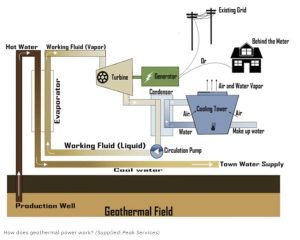 Click to enlarge | ABC Seven years ago everyone was excited in Winton Queensland. The new Geothermal project would only cost $3.5 million but it would save “$15 million” in electricity bills over the next twenty years and “should be operational by the end of 2016”.
Now in 2022:
Council launches legal action over $4m geothermal plant that’s never delivered power
The renewable energy project was set to be the only operating geothermal power plant in the country and was touted as the start of a geothermal windfall in the region. But more than two years since construction finished, it has never delivered power and is not operational.
“It’s bloody disappointing, to put it mildly, for such a great potential for the water that comes into town,” Winton Shire Council Mayor Gavin Baskett said.
What went wrong? “Technical issues”. The ABC doesn’t get to the bottom of this, but the water was just not close enough to boiling.
Martin Pujol, principal hydrogeologist at Rockwater, said at 86C, the Winton project would have been one of the lowest temperatures globally used to produce electricity.
Who did those funding estimates?
In a concept design study, project manager Peak Services — which is owned by the Local Government Association of Queensland (LGAQ)— estimated that the council could save more than $15 million over the first 20 years of operation.
My favourite line from 2016: “We wouldn’t have pulled it on if there were risks.” he said.
The town hopes to salvage something from the town’s white elephant, and no one relishes this failure.
Ultimately, the man-in-the-street needs to know that “free energy” is everywhere but it’s not free to collect. People are being sold a field of dreams and fluffy hope.
h/t Dave in Cooyal.
9.7 out of 10 based on 98 ratings
 The Great Realignment in politics has been coming a long time but it is now starkly lined up as a Class War in most of The Western World, just that quite a lot of voters don’t know it yet, and they are ripe for flipping. The Great Realignment in politics has been coming a long time but it is now starkly lined up as a Class War in most of The Western World, just that quite a lot of voters don’t know it yet, and they are ripe for flipping.
In Australia the tables were turned on a hundred years of history. The poorer half of the country voted for the conservatives, the richer half for the Labor Party, and the Richest of the Rich voted for the Teal-High-Fashion-Parade — the Gucci-Prada of Political Parties — the ones offering the Gold Plated Global Bragging Points!
I have a Platinium Frequent Flyer Card and I’m so Rich I Vote To Save The World!
People in Labor seats earned $8,000 a year more than people in Liberal electorates, but the Green-independents earnt $27,000 more. That’s not something they probably want people to hear.
Reversal of fortune: Labor electorates earn more than Coalition seats
Aaron Patrick Senior correspondent, Australian Financial Review
Households in Labor electorates now earn $8580 more a year than those in Coalition seats – a shift that could have profound effects on politics.
Labor and the Liberals changed places at the 2022 election. At $118,880 a year, households in Liberal seats now earn 2.6 per cent, or $3140 a year, less than Labor-seat dwellers on $122,020. And residents of Greens and independent-held seats are even wealthier. Their average household income last year was $145,690.
The income data may help explain why both main parties are behaving in ways contrary to their historical allegiances. The Labor Party has promised to subsidise childcare for families earning $500,000, and new Liberal leader Peter Dutton has acknowledged his party’s relationship with big business is breaking down.
“The Liberal Party is becoming Labor and Labor is becoming the Liberal Party,” an investment banker who lives in the Sydney seat of Wentworth said this week. “I’ve voted Liberal most of my life. Now I find myself reconsidering.”
The voting-income effects were seen across the metropolitan sprawls. Today, of the 15 highest-earning electorates, seven are held by independents, five by the Labor Party and three by the Coalition (Bradfield, Berowra and Mitchell.) While six Liberal MPs fell to “teal” independents, three of the poorest five electorates swung right.
Years ago when the free market and competition was a bigger part of the economy the wealthier people voted Right, or Conservative, while the workers voted Left. But now the government is the biggest corporation in the country (in all our countries), so it’s the biggest buyer, biggest employer and it decides all the rules as well. So the wealth and the votes has shifted from the fans of the Free Market to the fans of Big Government.
High Fashion isn’t a foundation for a long lived political force. The conservatives can shatter the illusion if they mark the neo-Greens as the rich social climbers who don’t give a damn about the poor or the environment. Then tag the Labor Party as the Party that serves the Bankers and Big Corporates. Notice where the money is and follow the trail. If the conservatives speak the Truth and for The People they will easily win.
9.8 out of 10 based on 80 ratings
8.8 out of 10 based on 9 ratings
Once, when the West could build things, problems got solved
Back in 2007 at least a few people still remembered that golden era. Here’s Dr Ziggy Switkowski, who at the time was head of the Prime Minister’s nuclear task force:
The French in 15 years went from zero reactors to 59 reactors and 80% of their electricity is nuclear. — ABC
Now we don’t even dream of success. If we had started in 2007, Australia could have had ten plants finished already.
Back in the 1970s and 80’s eh? Wow look at that take off…
The first nuclear plant in France was built by the EDF in 1962. Then the 1972 oil crisis put a rocket under the industry. So Prime Minister Pierre Messmer came up with a plan to build an unbelievable 170 nuclear plants by 2000.
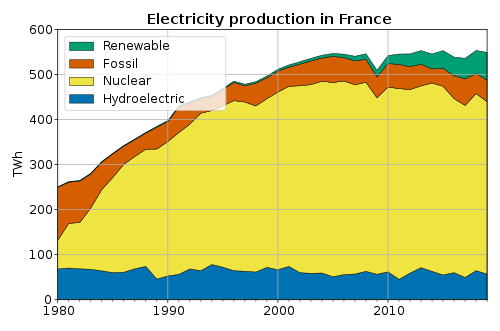 Theanphibian https://commons.wikimedia.org/wiki/File:Electricity_in_France.svg By the mid 1980s it was clear that would not happen, but not for the reasons you might think. The problem was not that they weren’t building plants fast enough, but that they were building them too fast. Demand wasn’t rising fast enough to keep up. The plants are most efficient running at 80-90% but by 1988 there were so many plants the capacity factor of France’s nuclear power stations was only running at 60%. There was too much generation to run them efficiently.
From Wikipedia, there are lessons here on how different the situation was: Three plants were started the same year
The problem of how to solve highly technical decisions is not like this either:
French nuclear power:
The announcement of the Messmer Plan was enacted without public or parliamentary debate.[16][17] Concern over the government’s action spread among the scientific community of France. The lack of consultation outside of political realms regarding the plan led to the formation of the Groupement des scientifiques pour l’information sur l’énergie nucléaire (Association of Scientists for Information on Nuclear Energy). 4,000 scientists signed a petition as a response, known as the Appeal of the 400 after the 400 scientists who initially signed it. [16]
The reason that the Messmer Plan was enacted without public or parliamentary debate, was because that there was no tradition to do that with highly-technological and strategically-important decisions in the governments of France and the parliament did not have a scientific commission with sufficient technical means to handle such scientific and strategic decisions, just like the public does not have such means. France does not have any procedure of public inquiries to allow the assessment of major technological programmes.[18] The plan envisaged the construction of around 80 nuclear plants by 1985 and a total of 170 plants by 2000.[16] Work on the first three plants, at Tricastin, Gravelines, and Dampierre started the same year[7] and France installed 56 reactors over the next 15 years.[19]
However by the mid 1980s it became clear that the Messmer plan had been overambitious. Nuclear power plants achieve their optimum economic value when run flat out, and the projected demand had not materialized. By 1988 France’s nuclear power plants had a capacity factor of only around 60%, whereas other countries that had not invested in nuclear power so heavily were nearer 80-90%.[7]
France’s population is about 3 times Australia’s. So perhaps we could only build, say, 18 reactors by 2040 –Where was that election plan?
At the moment, by 2040 we’ll be lucky to get one nuclear sub to plug into the grid.
*Ziggy says 59 power stations, Wiki says 56.
9.9 out of 10 based on 69 ratings
Children won’t know what a cyclone is
Hurricane activity, after human emissions and CO2 levels reach highest ever recorded, is now close to lowest ever recorded.
Based on a trend starting in 2019 major hurricanes may disappear entirely by 2035. What if Net Zero means “no cyclones”?
h/t ClimateDepot and NotalotofPeopleKnowthat
Spot the effect of Chinese coal plants on global hurricane frequency.
If the situation were flipped, try to imagine that the media would not write headlines like “Hurricanes near highest level ever recorded” and “Signs of Climate change seen in near record hurricane season”, or “Worst Cyclone season for thirty years!
Here’s The Guardian a year ago. But it could have been Forbes, The New York Times, the Washington Post. All of them..
It’s just one more Redpill moment to share with friends.
REFERENCES
9.9 out of 10 based on 41 ratings
|
JoNova A science presenter, writer, speaker & former TV host; author of The Skeptic's Handbook (over 200,000 copies distributed & available in 15 languages).

Jo appreciates your support to help her keep doing what she does. This blog is funded by donations. Thanks!


 Follow Jo's Tweets
Follow Jo's Tweets To report "lost" comments or defamatory and offensive remarks, email the moderators at: support.jonova AT proton.me
Statistics
The nerds have the numbers on precious metals investments on the ASX
|
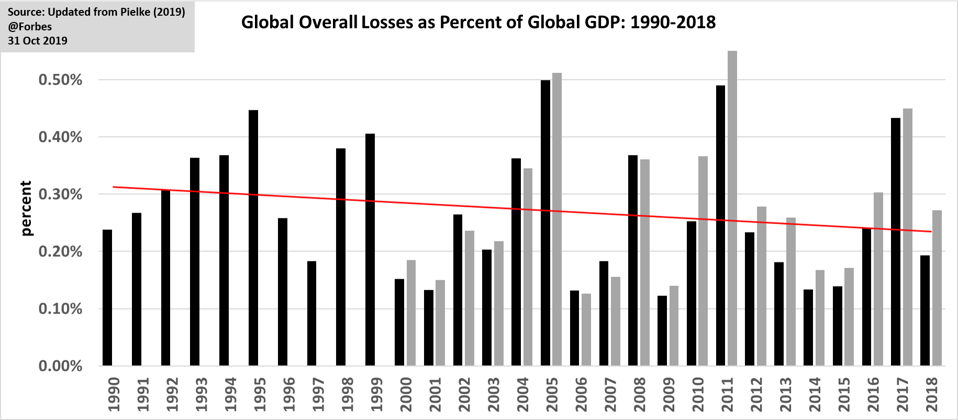



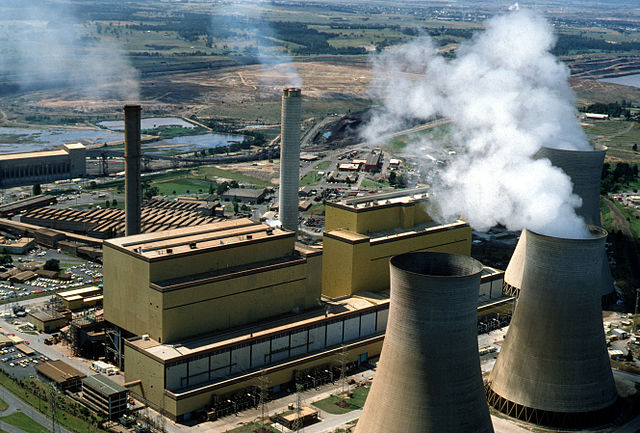









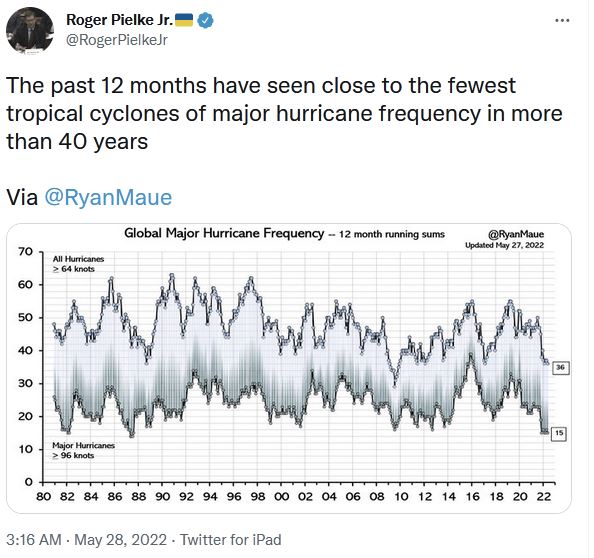
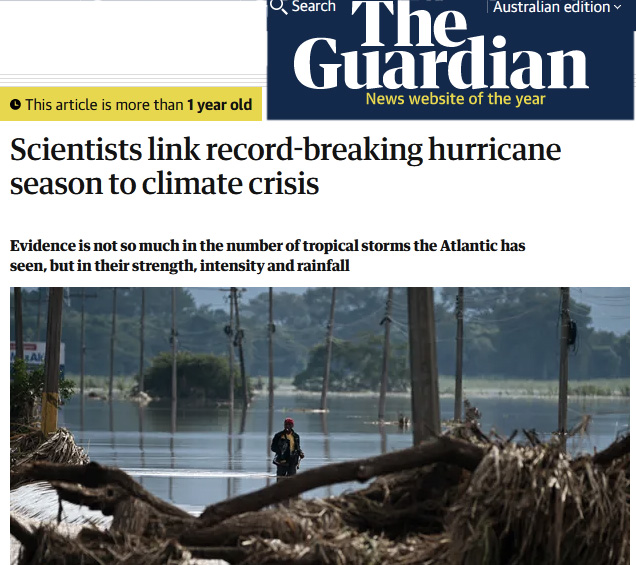











Recent Comments